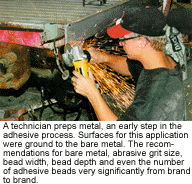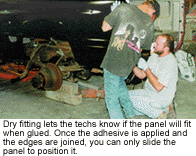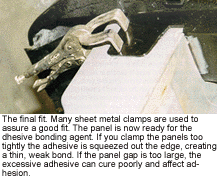With all the chatter about gluing panels on automobiles, you’d think that gluing stuff together was a new idea. Hardly.
The Egyptians were gluing furniture together for the Pharaoh’s tombs 4,000 years ago. How? They boiled up animal-hide glue from any old animal carcass. Basically, single-component, animal-hide glues are still made the same way and are still used on many wood products. Among other uses today, animal-hide glue is used to hold the abrasive on sandpaper.
More durable – and less smelly – glues are possible with synthetics. Synthetic rubber glues are stronger than animal-hide glues and stick together a larger variety of materials. All single-component glues are typically squeezed from a tube or brushed from a can onto the surfaces to be attached. Though easy to work with, they don’t provide enough strength to join automotive panels together.
Single-tube, moisture-cured urethane glues are used in collision repair – most commonly to set windshield glass and as seam sealers. Though in a single tube, the adhesive has a urethane (crosslinking) reaction with the moisture in the air to form a much stronger bond than ordinary synthetics. However, single-component urethanes still aren’t strong enough to attach vehicle panels.
As a result, the adhesives used for collision repair are all two-component (2K) products. 2K glues have the adhesive in one tube and the catalyst in the other. Once mixed together in the proper proportion, a new material is created (A + B = C).
During World War II, the Germans joined plastic panels inside submarines with some of the very first 2K adhesives. Today, 2K adhesive products are prevalent in collision repair and are constructed with three basic chemistries. Epoxy, urethane and acrylic glues are all used as structural panel bonding adhesives.

Which type should you use to repair the cars in your shop? Simple: The one the car manufacturer recommends. Virtually every automobile manufacturer uses adhesive bonding to attach door skins to their cars at the factory. As a result, most have a recommended repair procedure that includes adhesive bonding and hemming the edge of the door skin.
The Chemistry of Glue
- Epoxy glues – Epoxy glues co-mingle the resin and the catalyst to form a bond. Typically mixed 1:1, they create a very durable repair, are often easy to sand and are very forgiving when positioning panels. They provide lots of time to slide the panel around to reach an exact fit, but they also take as much as 24 hours to reach full cure.
- Urethane glues – Urethane adhesives have a catalytic reaction that’s affected by moisture and temperature and lend themselves to widely varying setup times. It’s relatively easy to make the urethane adhesives reach initial set in just a few minutes or delay it as much as several hours. Urethane adhesives also have a very high impact resistance to withstand lots of abuse. Often used to join plastic parts together, they’re found in the hulls of virtually every jet ski (talk about impact resistance). When the ski slams down off a tall wave into the water, serious jarring occurs.
- Acrylic glues – Acrylic 2K adhesives are the choice of several vehicle manufacturers. Acrylics lend themselves particularly well to joining metal to metal or plastic to metal. Acrylics have a fairly forgiving mixing ratio as well. If you’re not exact with the 2:1 or 1:1 ratio, the adhesive still cures in a reasonable amount of time.
Typically, the car manufacturer’s individual repair manuals will list the suitable adhesive products by name and part number. These are the glues that meet specifications to restore the door skin to OEM condition. But once past the recommendation to attach door skin panels with glue, vehicle manufacturers take very different paths.

And the OEMs Say …
Ford Motor Company makes careful note of the distinction between weld bonding and adhesive bonding. Weld bonding uses glue in conjunction with resistance spot welds. The American Welding Society (AWS) defines weld bonding as “a resistance spot welding process variation in which the spot weld strength is augmented by adhesive at the faying surfaces.” Adhesive bonding depends on the glue alone to hold the panels together.
Under no current circumstances does Ford think adhesive alone is sufficient. The car maker uses structural adhesives in its manufacturing process but confines them to improving the NVH (noise/vibration/harshness) of the vehicle, but not the structural strength. Whereas many adhesive manufacturers have performed actual crash tests to establish the suitability of their products, Ford hasn’t conducted its own field tests to include the effects of humidity, temperature, salt and exposure over time on structural strength. As a result, Ford’s panel adhesive repair recommendations stop at door skin attachment.
DaimlerChrysler, on the other hand, believes that weld bonding (resistance spot welds plus structural adhesive) is not only suitable for many panels on its vehicles, but is also 50 percent faster than conventional welding. The manufacturer says the 50 percent labor savings accrues from the following time savers: No holes are drilled or punched in the panel, no cool-down period is needed, no welds are necessary to grind and finish, and no warping occurs from the wire welder’s heat.
No OEM manufacturer recommends using adhesive to repair basic structural components like frame rails, rocker panels, pillars, core supports or struts. DaimlerChrysler restricts its recommendations to panels with metal thickness less than 0.9 mm (0.035 inches) – otherwise known as exterior sheet metal.
General Motors (GM) was an early user of adhesive bonding and has been gluing panels on vehicles since the 1980s. Remember the Fiero and those Camaro doors? Typically, GM limits its recommendations on non-plastic vehicles to door panels, quarter panels, deck lids, box sides, van sides and roofs. GM’s stand is that it will set specifications for adhesive performance and leave it to the various adhesive manufacturers to produce data proving their products work to the established specifications. Some GM installations call for MIG welding in addition to adhesive applications. Some panels must be MIG plug welded on one edge to establish the necessary strength and protection.
How Do You Use This Stuff?
While it’s generally a good idea to read the directions before using any product (yeah, right, like that ever happens), it’s particularly important when using structural adhesives. While I can’t get into specifics for all the products on the market, there are some common recommendations across all brands: Get the car square, clean the edges to be joined, test fit first and keep the room temperature above 70 degrees F. The recommendations for bare metal, abrasive grit size, bead width, bead depth and even the number of adhesive beads vary significantly from brand to brand.
Every brand also has a different set of steps and procedures. Some brands require the e-coat primer remain on the car; some require that not only must the e-coat be removed, but also the zinc galvanizing be ground off. Doing the wrong preparation for the brand of adhesive you’re using voids any warranty and greatly increases the chance of a comeback.

Once the vehicle is square and the two edges to be joined are flat, straight and cleaned according to directions, all adhesive manufacturers suggest you dry fit the part into place. Once the adhesive is applied and the edges are joined, you can only slide the panel to position it and should never remove the two edges from contact with each other by lifting the panel away. If you must remove the panel once contact has been made, some manufacturers suggest another bead of adhesive be applied on one or both edges; some manufacturers suggest you remove all the old adhesive and begin again. To get an adhesive bonded panel off, try using a heat gun to soften the adhesive and a putty knife to separate the panels.
Using sheet-metal screws will not only help locate the replacement panel onto the vehicle, but keep an appropriate separation between the panels. If you clamp the panels too tightly, the adhesive is squeezed out the edge, creating a thin, weak bond. If the panel gap is too large, the excessive adhesive can cure poorly and affect adhesion. At least as many sheet-metal clamps (likely even more) will be required to hold an adhesive bonded panel in place vs. a conventional plug welded panel. There’s no strength from the adhesive to hold location until the glue starts to set; the clamps do it all. The more clamps, the merrier.
Temperature and humidity can also play a huge role in how the structural adhesive performs. You could have done all the correct preparation and test fitting required by anyone and still have a failure. Some 2K adhesives stop reacting completely at 55 degrees F, while others slow down in cold temperatures to the point where they take days to set and cure. High shop temperatures can set a product so quickly that there’s no time to position the panel.
Keeping the shop between 70 to 75 degrees F is absolutely necessary. Once in place, most adhesives can be force cured to speed repair. Some brands want 140 degrees for 30 minutes, some want 160 degrees for 15 minutes and still others will take 250 degrees for 45 minutes. How will you know how long to cook it? Read the directions.
Bare metal corrosion is another critical issue. All adhesive manufacturers want the bare metal covered with something. Some are willing to leave the factory e-coat in place; some want brightly ground bare metal before the adhesive is applied. The bare-metal-first school still wants you to cover all the bare metal with adhesive or primer to prevent corrosion. The bead width and proximity to the panel edge are specified differently in each manufacturer’s instructions. Follow them to the letter.
The mixing nozzle that attaches to the end of the pump gun swirls the two components together on the way to the tip. Whether the nozzle is pre-notched or simply cut off further down the shaft, bead size is critical to a proper repair. Make sure you know how thick the bead must be for your brand. Many brands suggest wasting the first ribbon of combined adhesive the exact length of the mixing nozzle to ensure proper blend of the components before application to the vehicle.
It’s also necessary to remove any excess adhesive that remains after the panel is set. The adhesive that extends out from the bond can cause adhesion problems for some body fillers. Tech Cor warns that body filler may not stick to some adhesives, and several manufacturers caution against possible “read through” of the finished repair (when polyester filler is used over some adhesives, the repair can become visible after the car has been painted and exposed to the sun). Sand off all excess adhesive and carefully taper the repaired edge to prevent show-through problems down the road.
Which Glue Is for You?
Should you look for 2K structural adhesives that are epoxy-based, urethane-based or acrylic-based? As several manufacturers told me, the technician doesn’t need to know the chemistry involved, just that the particular adhesive is recommended for their application. Like paint brands, you may find the adhesive product from Brand X works better for you than the one from Brand Y.
All adhesives are temperature sensitive to some degree. Epoxy doesn’t work well in cold shop temperatures; urethane goes too fast in hot, humid shops. Acrylic products are less temperature sensitive but may not offer the specific bonding and flexibility characteristics the others do. You should simply choose the adhesive product recommended by the vehicle manufacturer for your specific bonding task and leave the chemistry to the chemists.
A Not-So-Sticky Subject
Adhesive bonding is likely to become more popular in collision repair. It reduces corrosive hot spots from welding and won’t burn off e-coat or galvanized coating. There’s no spatter to clean up, no protection for glass or interior is required, no panel warping, no corrosive action with dissimilar metals and better NVH making for quieter cars.
The adhesive manufacturers I spoke with suggested you choose a brand that’s tested its products by crashing repaired cars and comparing the results to the OEM panel in an identical crash. Likewise, everyone stressed the importance of following the directions.
All brands are different, so make sure you sit down and read through the instructions before you use a new brand on a repair. Your prior brand may have been completely different. If you have questions, call the manufacturer’s tech line for help.
Looking back, there’s no doubt we’ve come a long way. When the Egyptians boiled animal hides to make glue, they had no idea how far modern chemistry would take adhesives – and that someday it’d be possible to get a metal bond as strong as welding.
Writer Mark Clark, owner of Professional PBE Systems in Waterloo, Iowa, is a well-known industry speaker and consultant. He’s been a contributing editor to BodyShop Business since 1988.
Photos courtesy of Larry Bean Paint and Collision Repair.
|
A Sticky History
Though there seems to be new awareness about gluing vehicle panels, glue itself is nothing new. Egyptians glued furniture together for the Pharaoh’s tombs 4,000 years ago by boiling up animal-hide glue from animal carcasses. Today, single-component, animal-hide glues are still made the same way. We’ve even found ways to use the entire cow, including leather for shoes and automobile seats, and fat for tallow and glue. Even the leftover trimmed hide pieces that are too small for anything else are cleaned and cured in a water and lime mixture. After curing for two or three months, water is added to the hides, and the mixture heated to about 120 degrees F for a couple hours. The glue (protein from the collagen in the hide) is drained off and dried. That process is repeated three to four times with ever-hotter temperatures until all the glue is extracted. The Egyptian process was very similar. |
|
Beat the Clock
Most folks agree there’s some labor savings involved in using glue in addition to or in place of MIG welding. How much time is saved is up for discussion. Certainly many of the same careful metal-working tasks must be performed in either case. I-CAR suggests that adhesive bonding may be 20 to 25 percent faster than conventional methods but stresses that training is necessary for technicians to get it right. According to I-CAR, an evening clinic and demonstration videotape are generally all that are required to get a tech up to speed. |
|
Chemistry Review
Epoxy structural adhesives typically contain several components, the most important being the epoxy resin, around which the adhesive is formulated. Epoxy resins range from low-viscosity liquids to high-melting solids. A variety of materials can be added to the base resins: co-curing agents, cure catalysts, toughening and/or flexibilizing materials and fillers. Epoxy can be formulated into either one-component or 2K systems, although the latter is more popular in structural bonding. Cure temperature can also be varied, ranging from room temperature to 350 degrees F, although heat-cured adhesives usually outperform those cured at room temperature. Epoxy adhesives have very good chemical resistance and thermal stability but tend to be less elastic, especially at low temperatures, due to their limited elongation (less than 5 percent).
|
|
101 Uses for Adhesives
Acrylic structural adhesives are used in many applications outside our industry. One of the most interesting is in the huge, mountain-top, parabolic satellite dishes. The inside of the building-sized dish must be perfectly smooth to capture the maximum communication signals from far away satellites. Using rivets to join the panels leaves the inside of the dish lumpy. 2K acrylic adhesive makes durable, smooth, easily assembled, gigantic satellite dishes possible. |













